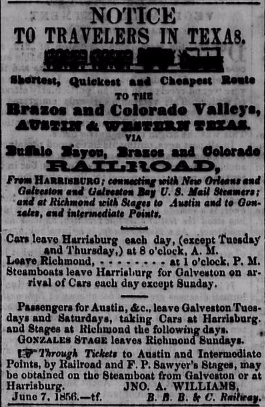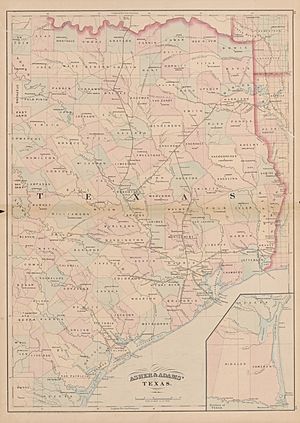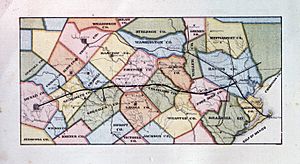Buffalo Bayou, Brazos and Colorado Railway facts for kids
| Overview | |
|---|---|
| Headquarters | Harrisburg, Texas |
| Locale | Texas |
| Dates of operation | 1853–1868 |
| Successor | Galveston, Harrisburg and San Antonio |
| Technical | |
| Track gauge | 1,435 mm (4 ft 8 1⁄2 in) standard gauge |
The Buffalo Bayou, Brazos, and Colorado Railway (often called B.B.B.C. or the Harrisburg Road) was the very first railroad to operate in Texas. It opened its first section of track in 1853. This first part connected Harrisburg, Texas (which is now part of Houston) to Stafford's Point. Before the American Civil War, the railroad reached Alleyton, Texas.
After the war, the railroad was sold. It was then renamed the Galveston, Harrisburg, & San Antonio Railroad. Later, the Southern Pacific Railroad took over this route. Today, it is part of the Union Pacific Railroad.
Contents
What's in a Name? The Railroad's Identity
The "Colorado" in the railroad's name refers to the Colorado River in Texas. It does not mean the state of Colorado. In its early days, people often called it the Harrisburg Road or the Harrisburg Railroad.
In 1868, the railroad got new owners. Its name changed to the Galveston, Harrisburg, & San Antonio Railroad (GHSA). This railroad was the oldest part of the Southern Pacific system. Since 1996, the Southern Pacific has been part of the Union Pacific. The original Buffalo Bayou, Brazos and Colorado route is now called the Union Pacific-Glidden Subdivision. It runs between Alleyton, Texas, and what used to be Harrisburg, Texas.
Building the Railroad: A Look at Its History
The idea for a railroad from Harrisburg to the Brazos and Colorado Rivers started early. In 1840, a newspaper in Houston mentioned plans for a "Harrisburg and Brazos Railroad." It said many workers were getting the track ready.
Who Started the Harrisburg Railroad?
The first successful attempt to build the Harrisburg Railroad came from Sidney Sherman. He was a Texian General and a hero of the Battle of San Jacinto. In 1847, General Sherman bought land in Harrisburg. He planned to sell these lots to help pay for the railroad. His goal was to connect Harrisburg with Galveston. This would allow goods from the Brazos River valley to go to Galveston, bypassing Houston.
General Sherman found investors from the northern states. He successfully got the company approved by the Texas legislature on February 11, 1850. The company officially started on June 1, 1850. Jonathan F. Barrett was the first president. Many important people in Texas were part of the company.
Laying the Tracks: From Harrisburg to Alleyton
Work on the railroad began in 1851 near Buffalo Bayou. Benjamin Franklin Terry helped prepare the ground for the tracks. He later became famous for leading Terry's Texas Rangers. In 1852, the railroad received its first locomotive, named the General Sherman. Soon after, the first tracks were laid.
By August 1853, about 20 miles (32 km) of track were finished. This connected Harrisburg to Stafford Point. The railroad's original plan was to reach Austin, the state capital. The line reached Richmond on the Brazos River in 1855. It then arrived at Eagle Lake in 1859 and Alleyton in 1860.
The American Civil War stopped construction towards Austin. However, the people of Columbus, Texas, built their own short track. This 2.5-mile (4 km) branch line connected their town to the railroad at Alleyton. They did this to make sure their town wasn't left out.
After the Civil War: A New Direction
After the Civil War, Texas faced financial problems. The railroad struggled and eventually failed. Luckily, its tracks were built to the standard width, which made it easier to sell. The tracks and trains were bought and the company was renamed the Galveston, Harrisburg, & San Antonio Railroad.
The new owners decided to extend the route towards San Antonio instead of Austin. They used the Columbus branch line as part of this new main line. The new owners also built the first telegraph lines along the route. After reaching San Antonio, the railroad continued to El Paso. There, it connected with the Southern Pacific. This connection helped make sure that the transcontinental railroad route would go through southern Texas.
Harrisburg vs. Houston: A Railroad Rivalry
Sometimes, people think this railroad started in Houston. But when the Harrisburg Railroad was first built, its eastern end was in Harrisburg, Texas. At that time, Houston and Harrisburg were separate cities. They were also strong rivals. The railroad helped Harrisburg grow.
However, in 1858, the Houston Tap Railroad connected Houston to the B.B.B.C. lines. Later, in 1880, the Texas and New Orleans Railroad connected Houston to New Orleans. This made Houston a major transportation hub. Even the Galveston, Harrisburg, & San Antonio line sold its properties in Harrisburg and moved to Houston. Later, Houston took over Harrisburg, making it a neighborhood within the city. Part of this area became the Port of Houston.
By the end of 1924, the railroad operated about 1380 miles (2221 km) of track.
Locomotives: The Engines That Pulled the Trains
The Buffalo Bayou, Brazos and Colorado Railway used several steam locomotives. These powerful engines pulled the trains along the tracks. The very first locomotive they bought was named the General Sherman. It was purchased in 1852 and named after Sidney Sherman, who helped start the railroad. Other locomotives included the Austin, the Columbus, and the Richmond. These engines were important for moving goods and people across Texas.




